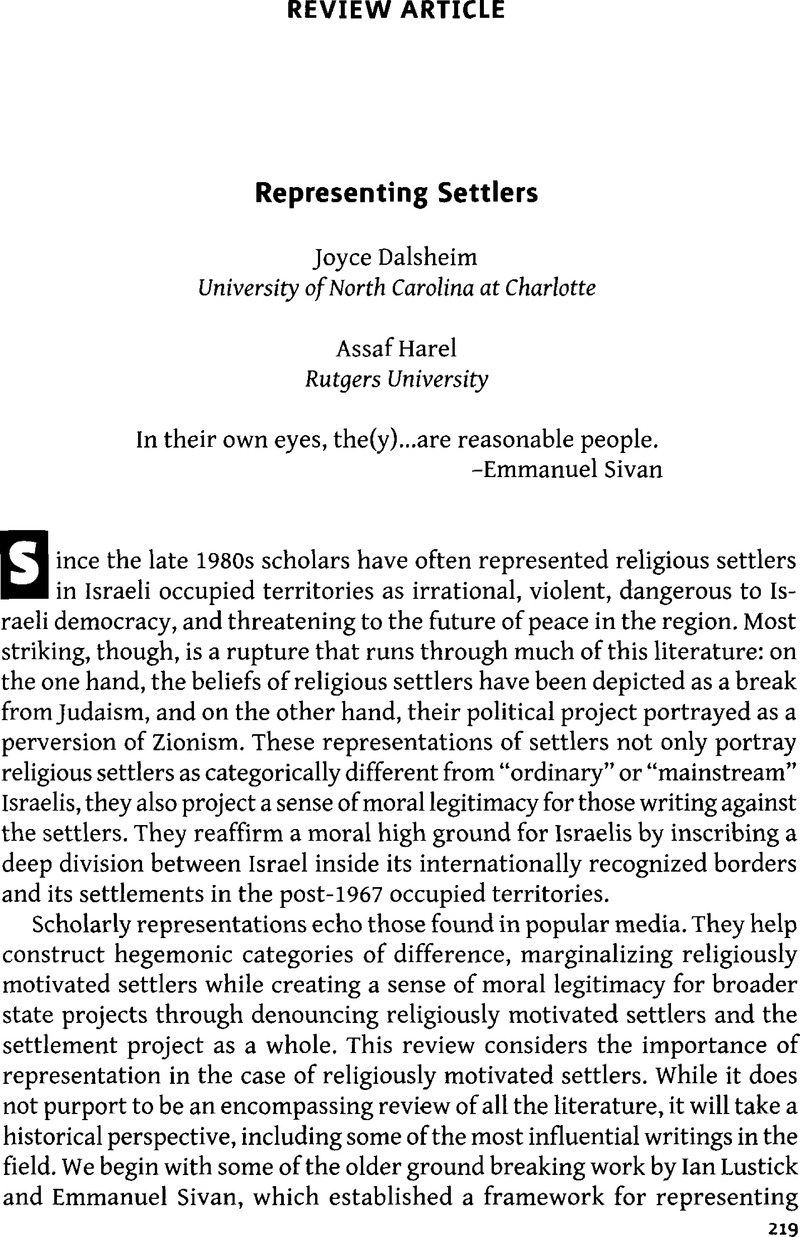Crossref Citations
This article has been cited by the following publications. This list is generated based on data provided by Crossref.
Dalsheim, Joyce
2013.
Anachronism and Morality: Israeli Settlement, Palestinian Nationalism, and Human Liberation.
Theory, Culture & Society,
Vol. 30,
Issue. 3,
p.
29.
Handel, Ariel
Rand, Galit
and
Allegra, Marco
2015.
Wine-washing: colonization, normalization, and the geopolitics of terroir in the West Bank's settlements.
Environment and Planning A: Economy and Space,
Vol. 47,
Issue. 6,
p.
1351.
Mayne, Hannah
2015.
The Changing World Religion Map.
p.
3227.
Hagemann, Steffen
2016.
Religiöse Identitäten in politischen Konflikten.
p.
241.
Feldman, Rachel Z.
2017.
Putting Messianic Femininity into Zionist Political Action.
Journal of Middle East Women's Studies,
Vol. 13,
Issue. 3,
p.
395.
Stern, Nehemia
2018.
The social life of the Samson Saga in Israeli religious Zionist rabbinic discourse.
Culture and Religion,
Vol. 19,
Issue. 2,
p.
177.
Harel, Assaf
2019.
Under the cover of the kippah: on Jewish settlers, performance, and belonging in Israel/Palestine.
Journal of the Royal Anthropological Institute,
Vol. 25,
Issue. 4,
p.
760.
Allegra, Marco
2019.
“It’s a great place for kids!”: the settlement of Ma’ale Adumim as a suburban safe space.
Etnografica,
Vol. vol. 23 (1),
Issue. ,
p.
181.
MCGONIGLE, IAN
2019.
In vino veritas? Indigenous wine and indigenization in Israeli settlements.
Anthropology Today,
Vol. 35,
Issue. 4,
p.
7.
McGonigle, Ian
2022.
“Again you will plant vineyards”.
HAU: Journal of Ethnographic Theory,
Vol. 12,
Issue. 3,
p.
856.
Allegra, Marco
and
Maggor, Erez
2022.
The metropolitanization of Israel's settlement policy: The colonization of the West Bank as a strategy of spatial restructuring.
Political Geography,
Vol. 92,
Issue. ,
p.
102513.
Reicher, Amir
2023.
Settler-colonialism in the West Bank from the standpoint of its Mizrahi settlers.
Ethnic and Racial Studies,
Vol. 46,
Issue. 7,
p.
1314.
Aharoni, Matan
2023.
The stranger within: Israeli religious women lead social change in community web-series.
Feminist Media Studies,
Vol. 23,
Issue. 6,
p.
2629.
Arieli, Tamar
and
Schaffer, Gad
2023.
Ideology, environment, and open space in conflict arenas: The discrepancies and harmonizing strategies of West Bank Israeli settlers.
Environment and Planning C: Politics and Space,
Vol. 41,
Issue. 7,
p.
1441.
Zahora, Jakub
2024.
‘When you come to Ariel, you come to serenity’: Affect, Aesthetics and Normalisation of Colonial Domination in Israeli Settlements.
Geopolitics,
Vol. 29,
Issue. 2,
p.
552.
Zahora, Jakub
2025.
Situated empathy: The politics and ethics of feeling with the other.
Qualitative Research,


